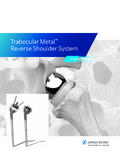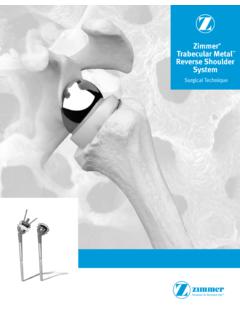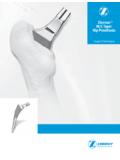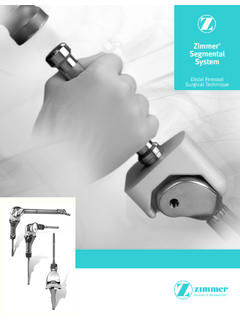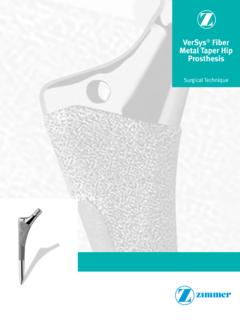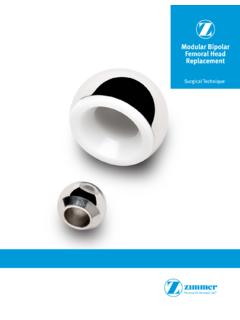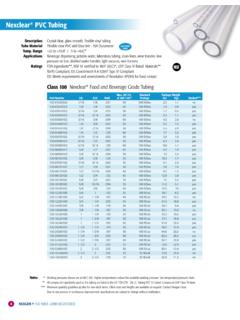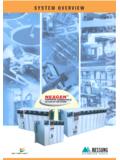Transcription of Zimmer NexGen LCCK - Knee
1 Zimmer . NexGen lcck . Surgical Technique for use with lcck 4-in-1. Instrumentation DISCLAIMER: This documentation is intended exclusively for physicians and is not intended for laypersons. Information on the products and procedures contained in this document is of a general nature and does not represent and does not constitute medical advice or recommendations. Because this information does not purport to constitute any diagnostic or therapeutic statement with regard to any individual medical case, each patient must be examined and advised individually, and this document does not replace the need for such examination and/or advise in whole or in part. Please refer to the package inserts for important product information, including, but not limited to, indications, contraindications, warnings, precautions, and adverse effects. Contact your Zimmer representative or visit us at The CE mark is valid only if it is also printed on the product label.
2 97-5994-302-00 Rev. 6 MC141388 8-25-15 Printed in USA 2015 Zimmer , Inc. INTRO Zimmer Instrumentation Surgical Technique for Legacy Constrained Condylar Knee Zimmer Instrumentation Surgical Technique for Legacy Constrained Condylar Knee TOC. Offset Stem Extension Introduction Patella Table of Contents Set Screws The NexGen Legacy Constrained Condylar Knee ( lcck ) SECTION PAGE SECTION PAGE. components are designed for use in both primary and Anterior revision surgeries (Fig. 1). Distal Femoral 1 Establish the Tibial Platform 1. Femoral Augment Augment Drill the Stem Base 7. The NexGen Revision Instruments are an intramedullary referencing system. All femoral and tibial cuts are based from Reamers or Stem Extension Provisionals located within the lcck Locking Finish the Tibia 4. Posterior Screw medullary canal. Femoral Augment lcck . The NexGen Revision Instruments allow the surgeon to convert Articular from a NexGen primary implant to a stemmed lcck implant Surface Trial Prosthesis 7.
3 Intraoperatively. This crossover can be accomplished after the Offset Stem 5. Stemmed tibial preparation has been accomplished and the femoral Tibial Tibial Plate cuts have been made via any of the NexGen primary tech- Wedge niques. If this is the case, proceed to "Prepare the Femoral Augment Canal" on page 21 of this technique. Offset Stem Tibial Augmentation 6. The four main objectives when using the NexGen Revision Extension instruments are: Step 1 - Re-Establish the Tibial Platform - Section 1 or The first goal is to establish a prosthetic platform on Fig. 1. solid existing tibial bone stock. This will provide a reference plane for evaluating the flexion and SECTION - Revision PAGE SECTION - Primary PAGE. extension gaps. Step 2 - Stabilize the Knee in Flexion - Section 2 2 Stabilize the Knee in Flexion 9 2 Stabilize the Knee in Flexion 21. Next, the femoral component size that will stabilize the knee in flexion is chosen and, if needed, augmentation Prepare the Femoral Canal 21.
4 To fit the femoral condylar bone stock is determined. Prepare the Femoral Canal 9. Step 3 - Stabilize the Knee in Extension - Section 3. Next, the knee is stabilized in full extension to A/P Wedge MIS Modular achieve collateral ligament symmetry and balance. Resect the Distal Femur 22. Finally, flexion and extension gaps are balanced. Evaluate Femoral Size 10. An acceptable position for the joint line is estimated to optimize patello-femoral tracking. This will aid in the determination of the proper articular surface Evaluate Femoral Size 24. thickness, distal femoral position (augments may be necessary), and femoral size that will stabilize the 3 Fluted Stem Stemmed Precoat Prepare for Femoral Trialing 10. knee in extension. Verify Femoral Rotation and Position Using the 4-in-1 Instruments 26. Step 4 - Implantation - Section 4. To further accommodate the specific needs of each patient, six tibial plate styles are compatible for use with the lcck Femoral Establish Flexion Gap and Stability 11.
5 Component (Fig. 2). Offset Stem Technique 28. 7 Fluted Stem Stemmed Porous The Part numbers listed are representative part numbers for shown procedures. See the NexGen Knee Profiler for a complete listing of part numbers. Fig. 2. Make the Anterior Cut 29. SECTION. TOC. COT Zimmer Instrumentation Surgical Technique for Legacy Constrained Condylar Knee Establish the Tibial Platform 1. Table of Contents Establish the Tibial Platform SECTION - Revision PAGE SECTION - Primary PAGE The tibial platform is re-established first, as its articular surface is always part of the articulation, irrespective of the 3 Stabilize the Knee in Extension 13 2 Stabilize the Knee in Flexion - cont. 30 position of flexion or extension. By contrast, the distal femur comprises part of the articular surface only in extension, and the posterior femur only in flexion. Make the Posterior Cut 30.
6 Establish Extension Gap and Stability 13. If necessary, create a starter hole by positioning the 8mm IM Step Drill approximately 15mm from the Make the Chamfer Cuts 30 anterior cortex just over the midpoint of the isthmus of the tibial canal. In a primary case, this is just anterior Make Femoral Augment Cuts 14 to the insertion of the anterior cruciate ligament (Fig. 3). Make the lcck Box Cut 31 Open up the medullary canal. TECHNIQUE TIP Prepare for the lcck Box 16 Drill the Femoral Stem Base 31 If the center of the tibia diaphysis and the center of the medullary canal do not coincide, an Offset Stem Extension will be required. Fig. 3. Perform Trial Reduction 32. Make the lcck Box Cut 18 TECHNIQUE TIP Reamer diameters start at 9mm and increase by 1mm increments up Establish Flexion Gap and Stability 33 to 24mm. Note: a 9mm Reamer reams 9mm in true diameter. Perform Trial Reduction 19 When initially reaming the canal, start with the 9mm Reamer and progressively ream until cortical contact is SECTION - Primary PAGE made.
7 The cutting flutes should be buried, without removing a significant amount of bone (Fig. 4). 3 Stabilize the Knee in Extension 35. Prepare the Patella 37 Warning: There is relatively scant bone available in the Establish Extension Gap and Stability 35 tibia, and perforation or fracture can easily result from aggressive reaming. Leave the Reamer in place as it will serve as a stable Prepare the Patella 37 aligned anchor for the Tibial Resection Guide and the rest of the instrumentation necessary for the tibial preparation. Fig. 4. TECHNIQUE TIP SECTION PAGE PAGE. The largest reamer that can be completely buried for tibial preparation may be smaller than the reamer used to prepare for the final diameter 4 Component Implantation 39. Femoral Component Preparation 43 and depth of the Stem Extension Provisional and Implant. Tibial Component Preparation 39 Instruments Attachment of Augments 45.
8 Technique 1 - "Back Table" Technique (Recommended). 40. Technique 2 - Intraoperative Technique 42. 8mm IM Step Drill NexGen Reamer 00-5978-014-00 00-5125-010-09. See Profiler 1. SECTION SECTION. 1 Establish the Tibial Platform Establish the Tibial Platform 1. For reaming depths prior to final provisional trialing Slide the appropriate Revision Tibial Boom (0 , 3 , or 7 ) (Fig. 5). over the Reamer or Stem Extension Provisional Assembly. NexGen Reamer NexGen Reamer NexGen Reamer Use the standard cut slot on any of the Tibial Cutting The 1st engraved line reams to the correct depth of 1st Engraved Line 2nd Engraved Line 3rd Engraved Line Guides for a flat cut. 90mm for a 75mm NexGen Sharp Fluted Stem Extension. Slide the selected Tibial Cutting Guide onto the appropriate Tibial Boom until it contacts the anterior tibia. The 2nd engraved line reams to the correct depth Then tighten the thumb screw (Fig.)
9 8). for a 145mm NexGen Stem Extension. 90mm Attach the Extramedullary Alignment Arch to the Tibial The 3rd engraved line reams to the correct depth 145mm Boom and tighten the thumb screw. Then insert the for the 200mm NexGen Stem Extension. 200mm Alignment Rod with Coupler through the Arch (Fig. 9). Fig. 8. Laying the desired Tibial Provisional Assembly Insure the resection surface will be 90 to the tibial next to the Reamer, and marking the depth to mechanical axis, by palpating the malleoli and noting ream with a marking pen can also aid in reaming the midpoint. Resection depth visualization. Line Fig. 9. Fig. 5 TECHNIQUE TIP TECHNIQUE TIP The Tibial Cutting Guide should be positioned so the Alignment Rod Be sure that the Reamer remains in line with the tibial shaft based follows the anterior tibial crest and points about 7mm-10mm medial on external tibial landmarks.
10 To the midpoint between the malleoli, and is also in line with the tibialis anterior tendon. After proper rotation and varus/valgus orientation has been A method of checking the reamer alignment with the canal is achieved, determine the appropriate depth of resection. to use a Spacer Block fitted with an Extramedullary Alignment Rod (Fig 6). 0 3 . TECHNIQUE TIP 7 . Posterior In a revision case, minimal bone removal is recommended. Tibia TECHNIQUE TIP Fig. 6 The purpose of this cut is to create a flat surface only. If necessary, apply a Tibial Wedge Augment Provisional to defective In a primary case, use the Tibial Depth Resection Gauge to bone to assure the Reamer is correctly oriented. define where the saw cut will be made. Insert the 10mm tab of the Gauge into the cutting slot (Fig. 10). Readjust and tighten the thumb screw on the Boom when the appropriate depth has been determined.

